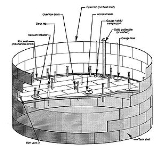
External floating roof tank
Encyclopedia
.jpg)
Storage tank
A storage tank is a container, usually for holding liquids, sometimes for compressed gases . The term can be used for reservoirs , and for manufactured containers. The usage of the word tank for reservoirs is common or universal in Indian English, American English and moderately common in British...
commonly used to store large quantities of petroleum products such as crude oil or condensate. It comprises an open- topped cylindrical steel shell equipped with a roof that floats on the surface of the stored liquid. The roof rises and falls with the liquid level in the tank. As opposed to a fixed roof tank there is no vapor space (ullage
Ullage
Ullage or Headspace refers to the unfilled space in a container, particularly with a liquid.-Etymology:The word comes ultimately from the Latin oculus, “eye”, which was used in a figurative sense by the Romans for the bung hole of a barrel...
) in the floating roof tank (except for very low liquid level situations). In principle, this eliminates breathing losses and greatly reduces the evaporative loss of the stored liquid There is a rim seal system between the tank shell and roof to reduce rim evaporation.
The roof has support legs hanging down into the liquid. At low liquid levels the roof eventually lands and a vapor space forms between the liquid surface and the roof, similar to a fixed roof tank. The support legs are usually retractable to increase the working volume of the tank.
Advantages
External roof tanks are usually installed for environmental or economical reasons to limit product loss and reduce the emission of volatile organic compounds (VOC), an air pollutant.Normally (roof not landed), there is little vapor space, and consequently a much smaller risk of internal tank explosion.
Disadvantages
Rain water and snow can accumulate on the roof, eventually the roof may sink.Water on the roof is usually drained from a flexible hose that runs from a drain-sump on the roof, through the stored liquid to a drain valve on the shell at the base of the tank. The hose often develops leaks and drains both water and product.
Note: The following 2 paragraphs (starting "Results of...") are direct wording from a For-Profit company & linked to their website meant for promoting sales of their specific product in a competitive industry where multiple different companies have similar products. This is in direct violation of "Wikipedia is not a...means of promotion," Sections 1) Advocacy, 4) Self-Promotion & 5) Advertising.
There are independent & industry derived testing of this issue and subsequently published papers from these studies that do collaborate the statements made, however they have not been uniformly adopted as fact by the industry. The following paragraphs should be removed as well as the link, and be replaced with documented, independently verifiable testing publications.
Results of Shunt Malfunctions
A poorly contacting rim-seal shunt on an EFRT is an example of where sparks might occur during lightning storms. If there is a non-conducting layer on the shell or the shunt, the spark will initially be an air-gap spark that will break down the insulation, followed by current flow in a poorly contacting area resulting in thermal sparking.
Shunt malfunction can result in months or years of downtime, single tank damage, damage to an entire facility, or damage to personnel. Shunts alone are too unreliable to take this chance, as testing has shown that, rather than reducing the risk of fire from lightning strikes, they may actually be increasing risk potential.
External links
- Use of floating roof storage tanks in Oil & Gas industry
- Compilation of Air Pollutant Emission Factors, Volume 1: Stationary Point and Area Sources. Chapter 7. Chapter 7: Liquid Storage Tanks
- For Profit Advertisement to be removed in violation of Wikipedia policies...http://www.alltec.com.my/prod_retractable_bypass_conductor_RBC.phpLightning Protection for Floating Roof Tank Retractable Bypass Conductor (RBC)

